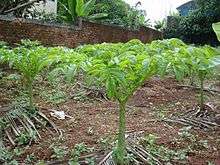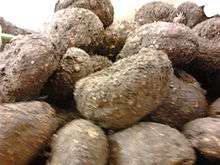Amorphophallus paeoniifolius
| Elephant foot yam | |
|---|---|
 | |
| Scientific classification | |
| Kingdom: | Plantae |
| Clade: | Angiosperms |
| Clade: | Monocots |
| Order: | Alismatales |
| Family: | Araceae |
| Genus: | Amorphophallus |
| Species: | A. paeoniifolius |
| Binomial name | |
| Amorphophallus paeoniifolius | |
| Synonyms[2] | |
| |
Amorphophallus paeoniifolius, the elephant foot yam[4] or whitespot giant arum,[5][6] is a tropical tuber crop grown primarily in Africa, South Asia, Southeast Asia and the tropical Pacific islands. Because of its production potential and popularity as a vegetable in various cuisines, it can be raised as a cash crop.
Description
Flower
The plant blooms annually around the beginning of the raining season. The flower bud emerged from the corm as a purple shoot, and later blooms as a purple inflorescence. The pistillate (female) and staminate (male) flowers are on the same plant and are crowded in cylindrical masses as an inflorescence. The top part is responsible for secreting mucus that gives off putrid, pungent smell that is used to attract pollinating insects, the middle part of the inflorescence contains staminate, and the base of the inflorescence contains pistillate. The stigmas of the female flowers will be receptive on the first day of the bloom, when the pungent smell will draw pollinating insects inside, and the inflorescence will close, trapping them for a night to allow the pollen deposited on the insect to be transferred to the stigmas. Later in the second day, the female flower will no longer be receptive of pollens, the male flowers will start to bloom, and the inflorescence will open again. This allows the pollen to be deposited on the emerging insects to be pollinated on different flowers, while preventing the pollens from the same inflorescence to fertilize itself, preventing inbreeding.
After 24–36 hours after the first bloom of the inflorescence, the inflorescence's female flowers will start developing into berries bright red fruiting bodies, and other parts of the inflorescence will start wilting away. The berries are red when ripe and are not quite round, being subglobose or ovoid.[7]
While the flowers are in bloom they also produce heat. They die after five days.
Uses
As food
In Bangladesh it is called ol kochu. It is usually eaten as mashed or in curries sometimes; though very rarely it is curried. The leaves are also eaten and are used to make a special leaf based curry.[8]

In Bihar it is used in oal curry, oal bharta or chokha, pickles and chutney.[9] Oal chutney is also called "barabar chutney" as it has mango, ginger and oal in equal quantities, hence the name barabar (meaning "in equal amount").
As medicine
The elephant-foot yam is widely used in Indian medicine and is recommended as a remedy in all three of the major Indian medicinal systems: Ayurveda, Siddha and Unani.[10] The corm is prescribed in those systems for a variety of ailments.
Notes and references
- ↑ Romand-Monnier, F (2013). "Amorphophallus paeoniifolius". IUCN Red List of Threatened Species. IUCN. 2013: e.T44393336A44531586. doi:10.2305/IUCN.UK.2013-2.RLTS.T44393336A44531586.en. Retrieved 5 February 2017.
- 1 2 "Amorphophallus paeoniifolius". World Checklist of Selected Plant Families (WCSP). Royal Botanic Gardens, Kew. Retrieved 5 February 2017.
- ↑ Nicolson, Dan Henry (1977). "Nomina conservanda proposita - Amorphophallus (Proposal to change the typification of 723 Amorphophallus, nom. cons. (Araceae))". Taxon. 26: 337–338. doi:10.2307/1220579.
- ↑ "Amorphophallus paeoniifolius". Germplasm Resources Information Network (GRIN). Agricultural Research Service (ARS), United States Department of Agriculture (USDA). Retrieved 5 February 2017.
- ↑ "Amorphophallus paeoniifolius". Integrated Taxonomic Information System. Retrieved 6 December 2014.
- ↑ "Amorphophallus paeoniifolius (Dennst.) Nicolson - whitespot giant arum". Natural Resources Conservation Service, United States Department of Agriculture.
- ↑ Quattrocchi, Umberto (2012). CRC World Dictionary of Medicinal and Poisonous Plants: Common names, scientific names, eponyms, synonyms, and etymology, Volume 1 A–B. Boca Raton, Florida: CRC Press (Taylor & Francis). p. 253. ISBN 978-1-4398-9442-2.
- ↑ "Kochu! (You can say that again...)". The Daily Star. 2016-07-26. Retrieved 2017-12-16.
- ↑ Nedunchezhiyan, M.; Misra, R. S. (2008). "Amorphophallus tubers invaded by Cynodon dactylon". Aroideana. International Aroid Society. 31 (1): 129–133.
- ↑ Khare, C. P. (2007). Indian Medicinal Plants: An Illustrated Dictionary. Berlin: Springer Verlag. ISBN 978-0-387-70637-5.
| Wikimedia Commons has media related to Amorphophallus paeoniifolius. |
